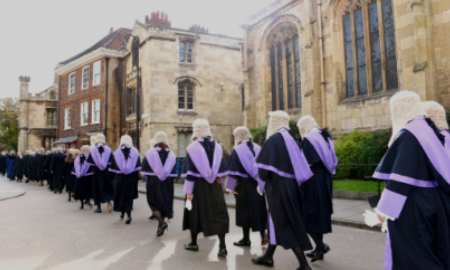Sign up for our free daily newsletter
YOUR PRIVACY - PLEASE READ CAREFULLY DATA PROTECTION STATEMENT
Below we explain how we will communicate with you. We set out how we use your data in our Privacy Policy.
Global City Media, and its associated brands will use the lawful basis of legitimate interests to use
the
contact details you have supplied to contact you regarding our publications, events, training,
reader
research, and other relevant information. We will always give you the option to opt out of our
marketing.
By clicking submit, you confirm that you understand and accept the Terms & Conditions and Privacy Policy
The proportion of ethnic minority and women judges in the England and Wales courts has increased marginally over the past year, leading to calls for efforts to improve judicial diversity to be stepped up.
Ethnic minority judges now account for 10% of judges, up by 1% from last year, while 37% of judges are now women compared to 35% last year. In the last decade the percentage of ethnic minority judges has increased by just 4% and women by 13%.
The figures, supplied by the Ministry of Justice, show that black judges make up just 1.27% of the judiciary (up by 0.01% since 2022). There has been no overall change in black judicial representation in the last decade.
In April 2023, according to the report, there were 156 Asian judges, 40 black judges, 84 judges of mixed ethnicity, 28 judges from another ethnic group and 2,818 white judges, with 357 declining to declare their race.
Commenting in a personal capacity, Hogan Lovells litigation partner Akima Paul Lambert noted: “Candidates from an Asian/Asian British or black/black British background were less likely to be recommended for appointment relative to white candidates.
“A lot of focus has been placed on increasing the pool of candidates. Now that we have a widening pool, we need to ensure that inherent structural biases in the selection, including in the composition of the [Judicial Appointments] Commission and the statutory selection processes, are reviewed and eliminated.
“We have come far. There is still some way to go, particularly regarding the racial composition of the judiciary.”
While there was a slight increase in the proportion of solicitor judges (32% compared to 31% in 2022), there was a big drop compared to 2014 when solicitors made up 37% of all judges.
Furthermore, while solicitors made up 48% of applicants compared to 35% of barristers, only 35% of solicitors were recommended for appointment, compared to 50% of barristers.
Law Society president Lubna Shuja said “more needs to be done” in improving judicial diversity. “Women still only make up just over a third of judges. The proportion of the judiciary from a non-barrister background remains persistently low despite solicitors making up the majority of applicants,” she said.
“The selection process needs to be urgently reformed. The requirement to consult sitting judges on candidates’ suitability, known as ‘statutory consultation’, must be reviewed with serious consideration given to removing it altogether, as it is not working fairly or transparently at the moment,” she added.
There is still some way to go, particularly regarding the racial composition of the judiciary
Colin Passmore, chair of the City of London Law Society, called the figures "disappointing", adding, “The wealth of experience of solicitors in the City of London is a resource which remains largely untapped.”
“We join the Law Society in urging that the process for solicitors to join the judiciary at all levels needs to be more adaptable to those from the profession who wish to join their colleagues from the Bar as judges.”
Bar Council chairman Nick Vineall KC was more emollient, saying progress was being made, but acknowledged it was not being made equally across the board. Like Lambert, he noted black candidates were disproportionately less likely to succeed than white ones, saying, “We need to continue efforts to understand why we are seeing this pattern.”
Vineall also picked up on disparities between black candidates and all ethnic minority candidates, which he suggested demonstrated the importance of granularity in data.
He argued: “As our Race at the Bar report stated, barristers from ethnic minority backgrounds should not be treated together as a single group, as that does not provide a complete picture.”
Dana Denis-Smith, founder of the Next 100 Years, which released a report on reducing gender equality recently said the need to improve diversity remained an urgent priority.
“Today’s statistics show female representation is on the increase and that more women entered the judiciary compared to men during 2022-23 – but women still only make up just over a third of judges and only 30% of judges in more senior posts.”
Denis-Smith added: “In 2023, the year that has seen the first woman appointed as Lord Chief Justice, I hope the profession can step up its efforts to support more women, especially those from ethnic minority backgrounds, to apply for judicial positions and make it to senior judicial roles.”
Email your news and story ideas to: [email protected]


1.jpg)


